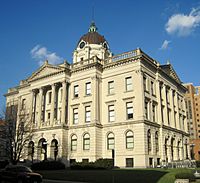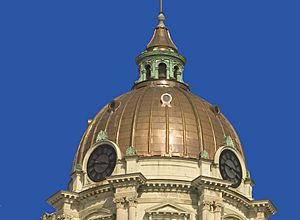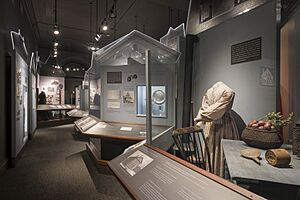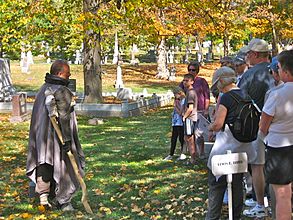McLean County Museum of History facts for kids

The Main Street façade
|
|
| Established | 1892 |
|---|---|
| Location | 200 N. Main St. Bloomington, Illinois 61701 |
| Type | History Museum |
| Public transit access | |
The McLean County Museum of History is a special place in Bloomington, Illinois, where you can learn about the past. It's like a big treasure chest of stories and objects from history! This museum is a main part of the McLean County Historical Society, which started way back in 1892 to study local history. The Museum moved into its current home in 1991.
Contents
History of the Museum
The McLean County Historical Society first met to share papers about local history. Soon, people started giving them old objects, like tools, clothes, and documents. In 1904, the society opened its first museum and hired someone to take care of the collections. In the 1930s, with new leaders and some government help, they carefully checked and organized everything they had. They also made lists of old records and local newspapers.
In 1972, a fire happened in the museum building, but luckily, the historical items were not damaged. After this, the museum decided to become more professional. In 1979, they made a plan to get a special approval called AAM accreditation, which they achieved in 1984. This means the museum meets high standards. They have been approved again several times, most recently in 2022. From 1989 to 1991, the old McLean County Courthouse building was made new and turned into the museum you see today.
The Museum Building
The museum building stands on a spot where three other courthouses used to be. The very first courthouse was built in 1831 from cherry and black walnut wood. In 1836, a new, bigger courthouse was built. Famous people like Abraham Lincoln used to work there as a lawyer! This building was also used by religious groups and even had the county's first newspaper.
Later, in 1868, a third courthouse was designed in a fancy Italian Renaissance style. But on June 19, 1900, a big fire in downtown Bloomington badly damaged the building. A company from Peoria, Illinois, was hired to design and rebuild it. The new courthouse, finished in 1903, was built in the American Renaissance style. It was used as the county courthouse until 1976. After that, it was used for county offices until 1988, and then it became the museum.
In 2002, the beautiful dome on top of the museum was fixed up. The old copper decorations were saved and reused, and the stone base was repaired. The clock inside the dome was replaced, and in 2004, the bell from the 1868 courthouse rang for the first time in almost 50 years! In 2005, the museum received an award for their great work in restoring the dome.
Museum Exhibits
The museum has a huge collection of items that show how McLean County grew and changed, from ancient times to today. These items tell stories about the different cultures, how people lived with their environment, politics, jobs, and local groups. The exhibits mostly use the museum's own collection, which has about 18,000 objects!
The museum's main exhibit, Challenges, Choices, and Change, helps you explore the lives of people who settled in McLean County. This exhibit is in four different rooms:
- Making a Home: This part shows how people from all over the world came to McLean County to make it their home, from Native Americans to people from Asia and Latin America in the late 1900s.
- A Community in Conflict: This exhibit asks who had the power in the community – the power to decide what was right, to earn respect, or even to cause fear.
- Working for a Living: Here, you can see how jobs changed from the 1820s to the 1990s, as new technologies developed. It shows the challenges and choices workers faced.
- Farming in the Great Corn Belt: This exhibit tells the story of farmers in McLean County, from the first settlers in the 1820s to modern farmers. You'll see the tools they used, the crops and animals they raised, and the tough decisions they made to be successful.
Abraham Lincoln in McLean County is another permanent exhibit. It looks at Lincoln's work as a lawyer in McLean County and how he helped start the Republican Party in Illinois. It also explains how he became president in 1860 and the strong connections he made with people in the community.
The museum also has three spaces for temporary exhibits: The Dolan & Behr Gallery, the Helen Alexander Bender Gallery, and the Merwin Gallery. These galleries show new exhibits every two to three years, focusing on different local history topics. Some past award-winning exhibits include Just Corn: The "Amazing" Story and A Turbulent Time: Perspectives of the Vietnam War.
You can also see the Tilbury Flash at the Central Illinois Regional Airport. This is a racing plane designed by Owen Tilbury from Bloomington in 1932. It was the smallest plane in the world when it was built and won many races!
In 2015, the museum opened the Cruisin' With Lincoln on 66 Visitors Center and gift shop on the lower level.
Research and Learning Opportunities
One important goal of the McLean County Museum of History is to help people research local and family history. They do this by having a library and archives that everyone can use. The Stevenson-Ives Library and Benjamin Hoopes Family Archives have many old letters, diaries, business records, newspapers, maps, photos, and stories from Central Illinois history, from the early 1800s to today.
The museum also offers fun and interactive learning programs for all ages. These programs connect local history to state and national history, using hands-on activities and objects. All programs meet the learning goals set by the Illinois State Board of Education. The museum even loans out "Museum-in-a-box" kits to classrooms, which have artifacts and activities for students. They also offer tours, field trips, and a History Careers Day Camp.
The museum has a special place called the Harriet Fuller Rust Discovery Room. In this room, you can experience what life was like without modern technology. Kids can try pushing an old steel plow, carrying water, gardening, milking a pretend cow, and even trying on old-fashioned clothes!
Since 1995, the museum has hosted the Evergreen Cemetery Walk. Every year, actors pretend to be different people who lived in McLean County, bringing their stories to life. The tour also teaches you about the art and design of the cemetery, its history, and how people used to bury their loved ones.
Awards and Recognition
The McLean County Museum of History has received many awards for its excellent work:
- Accredited by the American Alliance of Museums
- American Association of State and Local History
- Award of Merit: 1993, 1997, 1999
- Certificate of Commendation: 2001, 2002, 2004
- Leadership in History Award: 2020
- Illinois Association of Museums
- Award of Excellence: 1996
- Best Practices in Virtual Materials: 2018
- Best Practices in Educational Programming: 2018
- Museum Media Film Festival Award: 2019
- Superior Achievement in Community Partnerships: 2018, 2022
- Landmarks Preservation Council of Illinois Outstanding Restoration Award 2005




